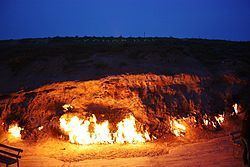Country Azerbaijan | ||
 | ||
Similar Ateshgah of Baku, Gobustan National Park, Palace of the Shirvanshahs, Maiden Tower, Old City | ||
Yanar Dag (Azerbaijani: Yanar Dağ, meaning "burning mountain") is a natural gas fire which blazes continuously on a hillside on the Absheron Peninsula on the Caspian Sea near Baku, the capital of Azerbaijan (a country which itself is known as "the Land of Fire"). Flames jet into the air 3 metres (9.8 ft) from a thin, porous sandstone layer. Administratively, Yanar Dag belongs to Absheron District of Azerbaijan.
Contents
- Map of Yanar Dag Azerbaijan
- Yanar dag near baku azerbaijan
- Geography
- Causes
- In popular culture
- References
Map of Yanar Dag, Azerbaijan
Unlike mud volcanoes, the Yanar Dag flame burns fairly steadily, as it involves a steady seep of gas from the subsurface. It is claimed that the Yanar Dag flame was only noted when accidentally lit by a shepherd in the 1950s. There is no seepage of mud or liquid, which distinguishes it from the nearby mud volcanoes of Lökbatan or Gobustan.
Yanar dag near baku azerbaijan
Geography
The Yanar Dag fire is never extinguished. Around this open fireplace the atmosphere is filled with the smell of gas. The flames emanate from vents in sandstone formations and rise to a height of 10 metres (33 ft) (different figures are mentioned in other references) at the base of a 10-metre-wide (33 ft) scarp below a hillside. Yanar Dag is described by the Geological Survey of Azerbaijan as "Intensive flames, to 1 metre (3 ft 3 in) high, develop for 15 metres (49 ft) along the base of a 2–4-metre-high (6.6–13.1 ft) and 200-metre-long (660 ft) tectonic scarp." The surface flames result from the steady gas emissions from underlying soils.
Even the surface of streams near Yanar Dag fire can be ignited with a match. These streams, which otherwise appear calm, are known as Yanar Bulaq: "burning springs." There are several such springs in the vicinity of the Vilascay River, where the local people take curative baths.
Alexandre Dumas, during one of his visits to the area, described a similar fire he saw in the region inside one of the Zoroastrian fire temples built around it. Only a handful of fire mountains exist today in the world, and most are located in Azerbaijan. Due to the large concentration of natural gas under the Absheron Peninsula, natural flames burned there throughout antiquity and were reported on by historical writers such as Marco Polo.
Most mud volcanoes are located off the Baku‐Shamakha road, about 40 kilometres (25 mi) from the city.
Causes
The reason offered for the Yanar Dag fires is the result of hydrocarbon gases emanating from below the earth's surface. Apart from Yanar Dag, the most famous site of such a fire is the Fire Temple near Baku, off the Greater Caucasus, which is a religious site known as ateshgahs, meaning temples of fire. It has also been inferred that such fires could be the cause for "thermal metamorphism."
Like the flames of Yanar Dag, the Ateshgah flame was a manifestation of the seepage of natural gas from porous strata, but the natural flow at Ateshgah ceased some time ago and the flames seen there now are fed from a gas main for touristic effect - whereas those at Yanar Dag are still entirely natural.
According to a study carried out by the scientists and geologists of the Geological Survey of Azerbaijan, analyses of four samples taken from Yanar Dag revealed that the area of maximum flux was situated at the upper side of the fault scarp - the very area from which the flames emanate. The value of microseepage recorded was 103 mg•m22•d21 at 30 metres (98 ft) from the fire, on the upper part of the study area. It has been inferred that the degassing area is larger than the measured area, and it is very likely that the microseepage is pervasive along the fault zone. This fault scarp is inferred as a part of the huge Balakhan-Fatmai structure on the Absheron Peninsula.
In popular culture
The naturally occurring fire burns in colourful flames most impressively at dusk, when tourists and locals can view it from nearby teashops. The numerous links to fire in the folklore and icons of Azerbaijan are attributed to a connection to the ancient Iranian religion of Zoroastrianism, which first appeared in this region over 2,000 years ago. This created a cult of fire worshipers in Azerbaijan before Islamic rule.
Yanar Dag continues to inspire artists in recent years, through a Finnish opera and a French Canadian stage play.
The site was used in the James Bond film The World Is Not Enough.
